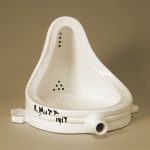The story of R. Mutt’s urinal, one of the most famous (and misunderstood) moments in modern art! Grab your metaphorical beret, because this tale is both hilarious and revolutionary.
So, picture it: New York City, 1917. The art world was buzzing with new ideas — Cubism, Dada, abstraction — and a group called the Society of Independent Artists announced an exhibit where anyone could display their work, as long as they paid the entry fee. No juries, no rejections. Total artistic freedom.
Enter Marcel Duchamp, a French artist with a mischievous streak and a sharp mind for irony. He decided to test that idea of “anything goes.” He walked into a plumbing supply store, bought an ordinary porcelain urinal, flipped it on its back, and signed it “R. Mutt, 1917.” Then he titled it Fountain.
When Duchamp submitted Fountain to the exhibition, chaos ensued. The organizers—ironically, including Duchamp himself—debated whether it was “art.” Most thought it was obscene, even insulting. The piece was quietly removed from view. Duchamp, amused but principled, resigned from the Society in protest.
Here’s the twist: Duchamp wasn’t trolling. He was making a deep point. Fountain asked, “What makes something art?” Is it beauty? Skill? Or is it the artist’s choice — the idea behind the object? That single porcelain urinal cracked open the door for conceptual art, performance art, and pretty much every creative rebellion that followed.
So, yeah — R. Mutt’s urinal wasn’t just bathroom humor. It was a declaration that art could be anything if the artist said it was. And that cheeky little plumbing fixture changed art history forever.
My son Julian and I have seen Fountain. Which is kewl.











